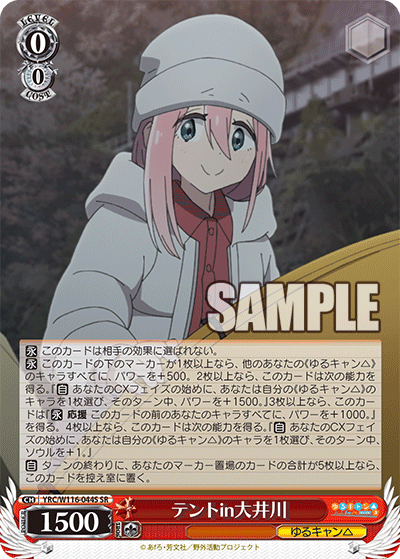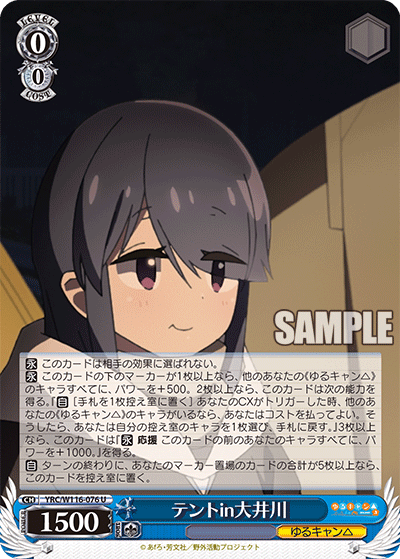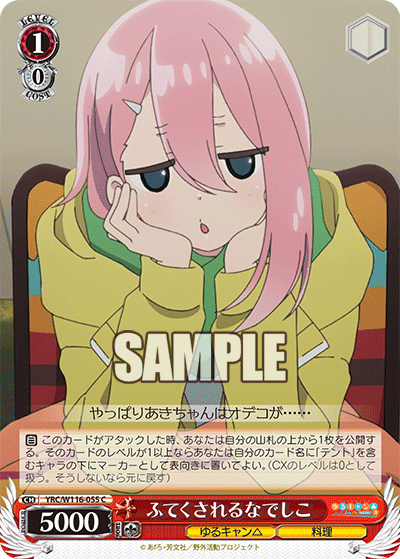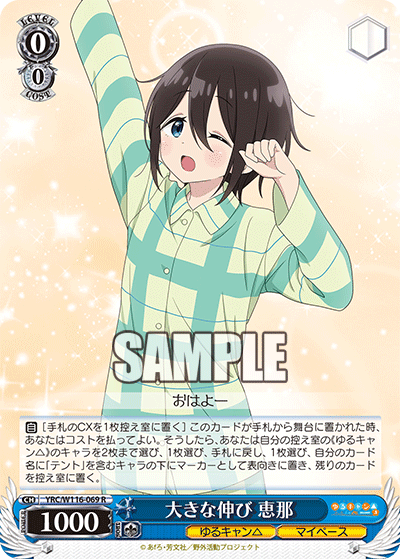I’m just going to say it: “I like tents.” I know that may sound weird and out of the blue, but what I want to focus on is more so the main feature or mechanic of the upcoming Yuru Camp set.



YRC/W116-012U テントin瑞牆山 (center)
YRC/W116-076U テントin大井川 (right)
As of this writing, there are only three tents within the upcoming Yuru Camp set release. Now keep in mind that both Nadeshiko’s (red) and Rin’s (blue) tents share the exact same name and are limited to a four-of in any combination in any deck. Now before we even delve into the effects of these cards, I think it is a rather flavourful and fun mechanic. The comfy campers (if you know the series) nestle down in their temporary structures as they prepare to embrace the beauty and wonders of mother nature. Thematically and mechanically, these cards are essentially back-row supports that bolster the girls with additional abilities.
For those not in the know, the fictional girls in Yuru Camp do visit real sites in Japan. The places referenced in their cards, the Oigawa River and the Miyuzaki Mountains are both places you can visit. Please make sure that you follow local rules and respect the nature if you do visit.
As for the mechanics of the tents, these tents grant additional boosts based upon the number of markers underneath them. Keep in mind that their effects stack, meaning that, for instance, if you have two markers, you will gain both the effects that are offered at a single marker and two markers. As for how to get markers underneath them, other cards in the set put markers underneath. Even though all three tents do carry different abilities, they all carry at least one universal ability where if there are five or more markers underneath them at any point, they will sacrifice themselves.



YRC/W116-008S-SR 楽しいおしゃべり あおい (center)
YRC/W116-069R 大きな伸び 恵那 (right)
Rather than judge the power levels of the tents and compare which is better, I would like to talk about the core mechanisms of the tent stacking itself (although, Nadeshiko is my favourite, so hers is superior). To place a marker underneath the tents, you must use the abilities on cards like the ones above. Outside of a few exceptions like this Nadeshiko shown, most of the cards that put markers underneath the tents serve an additional purpose and place a marker underneath the tents as an additional bonus effect.
Personally, I think this is a good design. By tying markers to using common effects, players do not have to play specific niche cards just to supply these markers. However, if wished for, players can accelerate the process by using cards such as Nadeshiko above that focus only on placing markers underneath the tents. Now it should be obvious that the faster a player stacks a tent, the earlier they can make use of the tents’ advantages.
Fundamentally, in terms of balance, I have one question I want to ask: How long does it take on average to maximize the tents with all their markers? This question alone will also answer how effective the tents are as the faster the markers are racked up, the more efficient their benefits will be throughout the game. It is undeniable that these tents are indeed powerful, especially for zero cost level zero cards that can enter the field as early as turn one. Outside of the green tent, it is important to note that both Nadeshiko’s and Rin’s tents have hexproof on the board, meaning outside of very specific situations such as that of targeted marker removal or board wipe, these markers are here to stay.
Theoretically speaking, if you were to re-purpose your entire hand and early game plan to putting markers underneath the tents, it is possible to maximize them out. However, given that every card played outside of a few exceptions have costs associated with them, I would doubt it would be a very efficient game plan to force these markers underneath at a breakneck speed. I think the mechanic was meant to be more of a passive function rather than an aggressive play. Most cards that place markers underneath the tents are generic profiles that could be played in any deck to begin with. They just have the added bonus of putting markers underneath.
Now it’s without a doubt that these tents are strong, especially that of their final mode when there are four girls underneath the tents. What’s more is that the effects are additive rather than superseding, meaning that you’ll always maintain the benefits at lower markers. One last benefit to mention is that, since these cards marker other cards, they also aid in given better deck compression when entering a new deck.
Still, the biggest question is that measure against time. Can you amass enough markers and gain access to the final tier of abilities before the game ends? Will it take too long to do so? When you compare and evaluate the value of the abilities versus the costs to stack the markers, is it ultimately worth it? To answer this question, we’ll just have to wait and see what and how players decide to build around the set.